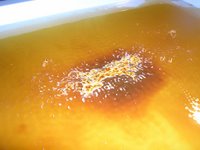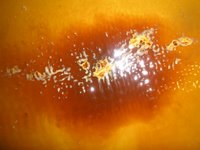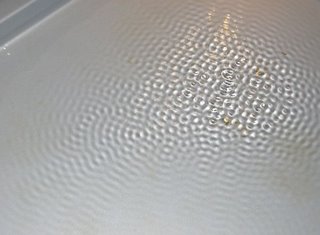
This has been something of a pet project in spare pockets of my time in the past couple of weeks. I've been extracting the audio track from video recordings made with my mobile phone in quiet places.
Naturally, mobile phone videos come with a significant degree of noise, both in terms of video and audio. I discovered something interesting about the audio track when I was messing around with a short video I shot whilst driving back from McLaren Vale about a month ago. Using iMovie I slowed down the video as much as I could to see the visual effect, when I played it back the audio track had been rendered into an expected drone albeit with a strange selection of little digital artifacts - clicks, swooshes and echoes. Nice stuff in other words, from a Tsunoda/Julius/Minard point of view.
Over the past week I've been making some more recordings in quiet places, both rendering at slowed down (droney) and high speed (cicada-y) settings. Quiet places for the reason the built-in mic is partial to distortion and clipping at loud volumes and broad frequency ranges.
I like these sounds because they sound very artificial. Although they are sped up and slowed down, they're faithful to their original form in a somewhat disembodied and plastic manner. When one sound event is mixed with others, their respective semblance becomes obscured and new sonic identities and environments are evoked.
The example below is a sample montage of several recordings from several different locations. The audio from the recordings has been modified using the simple technique explained above, in many cases the original video track would be slowed down/sped up in its entirity, then selections of the modified audio would be selected for collage.
audio example [1:49]
***
Regular visitors to this blog will know I've always been an aficionado of lo-fi technologies, though I can first remember being introduced to the lo-fi potential of mobile phones a couple of years ago when a UK friend Kate Donovan set up a project called Airvent. The project involves her phone calls to a Berlin radio station who broadcast and record her movements around London, the sound of her surrounding environment is filtered to the listener via the mobile's low fidelity signal. Occasionally traffic, conversations, jackhammers and the sound of birds can be heard slipping through the digital ether. I assume the title is an analogy of sorts, the airvent as a carrier, amplifier and filter of sounds whose sources/locations are unknown to the listener.
***
I've also started recording using unorthodox acoustic filters, including, (LO!) a teapot in the garden the other night.
August 05, 2008
Inside the Sony Ericsonn's digital lo-fi ear
June 19, 2008
Consultation & Peppercorns
My mentor Robin Minard is back in town for brief spell before he takes a 4WD up north into the wilderness for three months. We've caught up a couple of times over the past week and it's having some very positive outcomes in terms of research and my associated practice. The peppercorns are dancing on illuminated resonant surfaces and I think I might have something special on my hands. I'll be constructing the frames over the weekend.
June 12, 2008
Baking patterns
Over the long weekend I spent some time revisiting some experiments I first set about two years ago. Directly referencing Alvin Lucier's Queen Of The South (1972), the process involves activating a responsive surface and strewn materials with sine waves. In the case of the 2006 experiments, I used a keyboard, Marshall amp (with detached 60W loudspeaker), baking tray and strewn materials including cous cous, flour, sugar and nutmeg grains. These experiments led to some interesting results, but they felt ill-suited to my research at the time and were put to the side.
I came back to this idea for two reasons - firstly, because the most recent installment of the research[1] had included references to Rolf Julius' warum grau, warum gelb, warum grun (2002) which uses the process of activating a responsive surface as one element of the work. Secondly, as I am struggling to realise the original concept for my third and final creative work[2], I decided to return to a previously explored idea that is a) easier to realise, and b) more suited to the scope of the research.
For the new experiments I retained the previous materials with the exception that I decided to use two small matching loudspeakers for broadcasting the sine waves and a very simple Max/MSP patch as a means of generating the sine waves. The benefit of using this simple sine wave generator opposed to the keyboard is it can accurately sweep through the resonant frequency range of the baking tray, finding its key areas of resonance and vibration. 
At first I positioned the loudspeakers at various points beneath the baking tray in an attempt to activate different points of the surface at closely tuned resonant frequencies. This was successful, though I found a better and more visually interesting result was achieved by positioning the loudspeakers close together beneath a resonant area of the baking tray. Using a slight difference in resonant frequencies (i.e. 161 Hz and 163.3 Hz) an interference pattern is created, thus causing amplitude modulation and a pulse-like vibration. This causes the strewn material to start and stop its propagation across the surface of the baking tray in regular timed pulses. The rate of pulses can be adjusted by either tuning the resonant frequencies further or closer to each other.
The two embedded videos document this process with cous cous, black peppercorns and crushed leaves as strewn materials.
The first experiment with cous cous and black peppercorns was good as it was able to evoke an reasonably accurate phenomena of wave propagation across the responsive surface. The cous cous is used as homogenous material (textural and specific to the wave movement), whilst the peppercorns serve as more individual markers which illustrate how individual grains are caused to propagate - sometimes very chaotically - across the responsive surface. 
The second experiment is similar with the exception that crushed leaves are used in the place of cous cous grains. The array of subtle colours and shapes of the crushed leaves make the process a little more visually stimulating, but lack the phenomenological accuracy of the cous cous as a strewn material.
Additional findings for further investigation relate to how the resonant frequency of the baking tray changes when different materials in different quantities are put on the surface. The explanations for this are relatively easy to explain, but are curious nonetheless.
***
I'm making plans over the week to expand on what I've done so far - in aesthetical/conceptual terms as well as some technical considerations - to give the work more relevance to the research, some identity and distance it from directly referencing Lucier and Julius' work.
More soon.
_________________
[1] http://tristanlouthrobins.blogspot.com/2008/05/research-progress-report-presentation.html
[2] http://www.stillandmovinglines.blogspot.com/
May 10, 2008
Noise Improvisations

I've been spending the last hour playing aorund with some noise samples in the Sumi_matic (Max 4 version because the 5 version is clicking for some reason.)
I'll forever be amazed just how much you can get out of a simple little bit of noise.
Using a five-second 'proto-snare' noise sample, it is uploaded to the Sumi_matic's 8 loopers at fixed playback speeds; the first four at around 400 loops p.s - which is how the buzzing effect is emulated. The remaining four loops are set at around 90 loops p.s, giving these a more rumbling but slightly harmonic sound. The improvisation below is just me playing around with the playback speeds. I'm quite pleased and suprised by the results. Also the filter in Sumi_matic is set to a resonant envelope, hence the (erm) resonant sound.
Noise Improvisation #1 [3:00]
September 08, 2006
[8.9.07] Water, Materials & Sound (II)
1. Water, paper, instant coffee.
A piece of paper is immersed in a very shallow amount of water, as the metal surface vibrates and makes the sound waves visible on the surface of the water, grains of instant coffee are dropped in the centre of the paper. A low sine wave frequency of 65.4 Hz (i.e C2) was used to resonate the surface of the tray, only a small amount of volume was required to make the waves visible.

As you can see by the image (above), it is a little hard to tell whether the sound waves are affecting the movement of the dissolving coffee grains. Paper was used with the intention of allowing the coffee to stain its surface, in effect 'imprinting' sound and giving it some kind of permanence.
2. Water, instant coffee.
Similar method, though no paper used this time, just the shallow water and the coffee grains. The same sine wave frequency of 65.4 Hz was used.
Again, difficult do really determine the waves influence of the dissolving coffee grains, but visually it was quite interesting.




3. Water, ground nutmeg.
Finally, some success. Nutmeg grains were immersed in the shallow water, and one the had settled on the surface of the tray, the C2 tone was played and left for one hour. The images below show the formation state in ten minute intervals. To observe the details of the process I uggest you click on the image below to enlarge it. (don't panic it's 'websafe')

I would say that my experiments in this field have been exhausted for the time being. I will revisit them when I can find a means of applying them in an appropriate installation and/or performance context.
August 29, 2006
[29.08.06] Visualising sound with water and light

With the setup of speaker, water tray and directional light (amp and oscillator out of shot.) What I'm doing here is trying to move the waves around manually.

Example one: A low frequency resonance (note large bandwidth). The metal tray has many resonant nodes, the complicated formation is due to the waves reflecting off the edges and corners. It would be interesting to see a more pure representation of a single spherical formation - though this is proving difficult to acheive.

Example 2: A much more elaborate formation at a higher frequency with a shallower amount of water. A blue bulb was being used at the stage.
August 01, 2006
[1.8.06] Research Progress: Ecotone
I will set up a series of objects, or vessels if you will, (vases, glasses, cooking trays, etc.) and attach contact mics inside them - one to receive an input signal and the other for the output siganl (a feedback signal will provide sound). Then once the feedback signal (or threshold) is audible and consistent, I will set up an automated temperature/humidity control and let the process and the room do the work. It is going to be a lot of trial and error, but at least this an official point of departure.
July 31, 2006
[31.7.06] Research Progress: Sine Tests
I.
In my room I did a couple of experiments with feedback modulation of a fundamental sine wave - a process of fixing a microphone close to a speaker cone, raising the mic input to the feedback threshold and tweaking the EQ on a mixer. Through the speaker I played a sequence of single sine waves, starting with 110Hz then shifting 0.5Hz every thirty seconds. As it played back I wasn't necessarily interested in tweaking the EQ all over the place, I was more content with setting the EQ to a fixed position (so that feedback signal was consistent) and letting the periodic shift of frequency of the sine waves do the modulating. There were some very interesting results - pulse patterns and harmonics shifted in and out of phase with each other as the fundemental frequency shifted away from the EQ presets. I'll be doing more tests tomorrow as there are some acoustic phenomena that remain unclear (the room's resonant frequency may be playing a part as well - I'm not sure.)
II.
I then moved my gear out into the Shultz staircase and played some sine and square waves into the space. It was really just a bit of fooling around. In such a resonant area as a stairwell, high-ish frequencies such as 880 - 1200 Hz are suited best as they are reasonably directional and capable of being reflected through the staircase, opposed to a lower frequency which just oozes all over the place. Tomorrow I may explore the prospect of using two sine waves, seperated by a couple of floors and tuned slightly apart from each other - say 1100 and 1123 Hz.
III.
I took the latter idea into the EMU performance space next, pairing a fundamental frequency of 880 Hz with a modulating frequency of 881Hz which shifts by 1 Hz every thirty seconds. As these waves were played into the space, I went over to the Steinway piano and played A5, B5 and C6 notes, observing how the richness of the piano's harmonics caused the sine waves to heterodyne and spin off in various directions. This is a method explored by Alvin Lucier in many of his works, specifically Still and Moving Lines In Families Of Hyperbolas (1973-4) and Wind Shadows (1994).
So, an exiciting day of practical activity, more tomorrow (and some pictures.)



